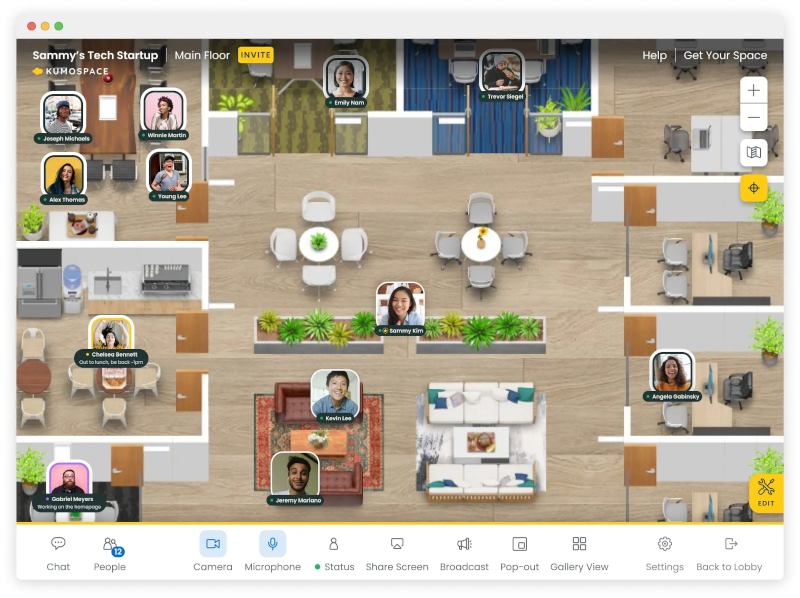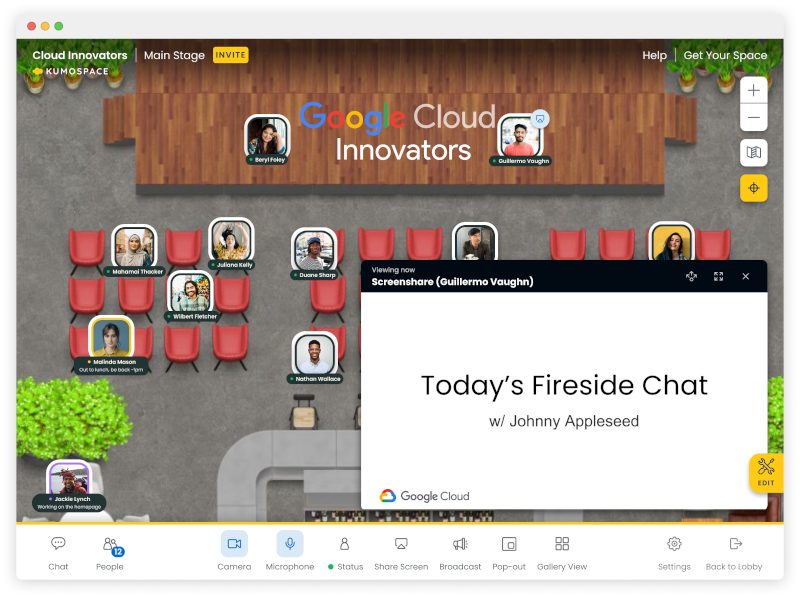
Kumospace increases activation by over 40% with experimentation

43%
Before Kumospace, remote work didn’t always feel cohesive.
Imagine stepping into a world where the boundaries between physical and digital blur, where every interaction feels as natural as a handshake, and every chat thread as real as a conversation.
This is the future of remote work that Kumospace is ushering in.
As a business, Kumospace’s challenges are unique. Its goals are closely aligned with its users’ goals, placing emphasis on meaningful connection, natural communication, and even helping users’ careers improve—all in a digital environment.
And with powerful community-focused features like virtual events, conferencing, spacial audio, and more, Kumospace provides platforms for users hosting recruiting events, community hubs, providing educational services, hosting student life activities, and even holding religious services.
Lauded as innovative and engaging by NASA, and trusted by companies like Google, Sony, Amazon, and more, Kumospace is redefining how remote teams work, grow, and evolve.
Close to the heart
To David Sepulveda, Head of Data at Kumospace, he’s solving a problem that he personally resonates with. “We’re on a mission to enable remote teams and power remote workers to thrive. We want our virtual office platform to actually feel like an office.”
And to his point, Kumospace really does feel like an office. When users log on, they’re greeted with a beautifully rendered office building with furniture, foliage, personal desks, conference rooms, and avatars of their coworkers’ faces.

On the design of the unique user interface, David describes one subtle data point that has an outsized impact. “We find that it’s helpful to have a visually rich space, and even have 3D artists on staff. Our 3D renderings are all original.”
Focusing on what matters
While Kumospace has been data-driven since its inception, it has done a remarkable job keeping its focus on adding value for its users.
“It’s easy to be distracted trying to deploy the latest technology. What matters the most is [the reliability and consistency of] seeing each other, hearing each other, and interacting with each other.”
As the first Data Science hire, David explains that the founders wanted to invest in developing a data-driven culture early on. They’re mindful of striking a balance between adding features for features’ sake versus refining what makes Kumospace an attractive virtual office.
“When we decided to build a mobile app, we needed to be very judicious in deciding which features to take into mobile. It’s easy to just add everything, but we need to focus on what adds value and moves the needle.” “We focus on features that imply meaning,” he summarizes.
David joined Kumospace when the team consisted of 20+ employees, primarily Engineers. “That’s sometimes considered early, but it speaks directly to the vision of the cofounders in terms of investing in analytics,” he adds.
“Nearly 70% of the company was adjacent to experimentation in some way. My stakeholders include the Product, Engineering and Marketing team, who run experiments on our website to generate more leads.”
Early wins that impacted core business metrics
Kumospace began running experiments throughout the user journey, with a particular focus on the onboarding and activation stages.
- Improving the sign-up flow: David shared how they tested several ideas such as removing extraneous links from their signup flow, which positively impacted completion rates.
“When we removed distractions or ‘escape hatches’ in the signup flow, we immediately saw that more users made it through.”
- Driving active use and retention: David observed a clear correlation between user activity and retention. He explained, “Day zero is golden, the moment of truth.”
“We created metrics to measure how many users are active on day zero. We then used Statsig to make decisions such as which media type is more effective to help a user successfully complete onboarding.”
David reiterates that Kumospace’s use of Statsig extends beyond growth metrics, and includes user experience optimizations as well.
“Companies trust us with their work, so we continuously invest in enhancing audio/video rendering and improving the performance of our applications. Statsig helps us in measuring performance and reliability metrics, such as frames per second, across different device types.”
Unexpected results and more wins
David also credits Statsig for helping them build a strong data-driven culture. More team members began generating ideas for growth and testing them out. This often led to unexpected, counterintuitive results, enabling them to mitigate metric regressions.
“We learned that some features were not positively impacting our metrics. We tested different messaging for customer segments to develop personalized copy. Ones we were bullish on didn’t perform as expected,” explained David, highlighting how intuition is often incorrect.
“We also had a surprise when we changed the background color on the signup screen. Everyone thought it wouldn’t work, but we were surprised to see a measurable impact when we tested it.”
Using data has also helped David uncover hidden details that impact metrics. “We also measure concurrency, because multiple users in one space has an impact on retention.”

Optimizing the onboarding flow with testing, not guessing!
David shared an example of how adding steps to the onboarding flow with an intake questionnaire succeeded, much to their surprise. This allowed them to capture details to better understand their users’ pain points without negatively affecting account creation rates.
Similarly, they experimented with adding onboarding slides and extending the length of the tutorial video to include more tips and tasks, aiming to educate new users better.
“We were genuinely concerned about adding steps to our onboarding process, but Statsig enabled us to test our ideas rather than rely on guesswork. This unlocked new learnings and wins for the team.”
The trade-off proved to be valuable, yielding significant learnings and wins for the team. “Only 4.4% of users skipped our onboarding slides, and 10% of users completed the longer tutorial, subsequently spending more time on the product.”
Bringing ‘big-tech’ experimentation capabilities to a startup
David played a pivotal role in fostering a culture of experimentation at Kumospace, empowering Engineers to double their testing velocity.
“What I am most proud of is the up-leveling in the complexity of the experiments we are shipping, particularly with the use of custom IDs,” he commented.
Within a year, experimentation became widespread throughout the company.
Rethinking day zero
Data has helped David shift focus from overindexing on first-session metrics, and widening the scope to the entire day. “We created metrics to measure how active users are on day zero. The success metric computes the average number of minutes both for the entire first day and for the first session.”
He continues, “We use these day zero metrics to measure how people are navigating and figuring out the product.”
They also focus on retention, and are always looking for new ways to make testing more innovative. “We run experiments with custom IDs which let us measure performance at a space level, and saw relations between activity and retention.”
“We are tackling more complex use cases across geographies with users across the web client, desktop app, and mobile apps, helping us learn faster about what our users value more in each case. We are also running more concurrent experiments and constantly thinking about new things to test.”
Building with Statsig
David enjoys having the ability to tailor Statsig to suit diverse business needs. “Kumospace is very tech-centric, and they love the ability to configure Statsig very deeply—and the feature reach that it provides.”
He also appreciates the support that the Statsig team provides both publicly and within their personal Slack channel.
“The Statsig Support team is like our partner. We are big fans of the Slack channel; we get incredible responses that help improve our knowledge given that our Engineers have different levels of experimentation experience."
“We all want to succeed together.”

David Sepulveda
About Kumospace
"We want to build the world’s most powerful virtual HQ. Our mission is to help remote teams iterate faster, collaborate across silos, and create a true sense of belonging. We are adding desktop and mobile apps to make it as easy as possible to show up for your team in Kumospace, whether you are at your desk or on the road. Every day we add new integrations with other remote work tools, so that teams can get everything they need done, without ever leaving Kumospace. You could say that we are building a B2B metaverse."